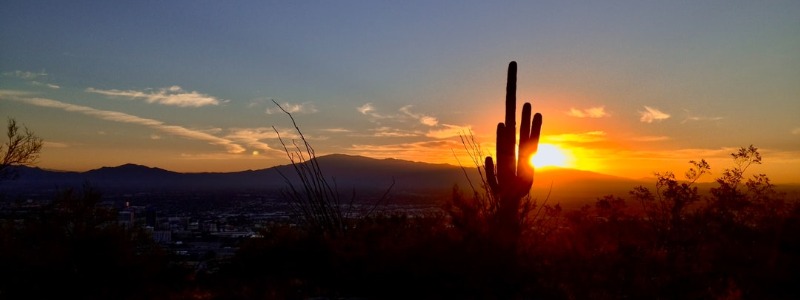A favorite spot for walkers and runners, Tumamoc Hill offers panoramic views over the city from the world’s oldest known desert research preserve.
Sentinel Peak, or “A” Mountain, with its giant varsity letter made of painted rocks crowning the hillside, is a well-known Tucson landmark west of downtown. But rising alongside it is Tumamoc Hill, which has been quietly making history for over a century as the first site dedicated to desert research and preservation.
From Botanical Laboratory to National Historic Landmark
The name of the hill comes from a word that means “regal horned lizard” in the O’odham language. The Native Americans who lived in this region thought it resembled a giant lizard basking in the sun. It is pronounced “tsyu-ma-moc.”
In 1903, the Tucson Chamber of Commerce leased the 860-acre preserve to the Carnegie Institution, which founded the Desert Botanical Laboratory here. Early ecologists came to Tumamoc to study how plants survived and thrived in the extreme heat and dryness of the desert.
They published much of their research in The Plant World, which became North America’s first professional journal of ecology. It is still published today under the title Ecology by the Ecological Society of America. Seven of the Desert Laboratory’s researchers were among the Society’s founders.
The University of Arizona bought Tumamoc in 1960 and has maintained it as a reservation for desert research and education. In 1976, the buildings and original study plots of the Carnegie Desert Laboratory have declared a National Historic Landmark, a designation that was expanded to the entire ecological preserve in 1987.
First Restoration Ecology Project in the World
When the first researchers arrived at Tumamoc, they found the land had been overgrazed for decades and was gouged by rock quarries. Professor Volney Morton Spalding decided that the only way to study the natural plant ecology was to return the land to nature.
Spalding wanted to see what the desert looked like before the first Europeans arrived. He fenced off the entire scientific reserve in 1906 to keep out horses and cattle and shut down the quarries, which allowed native plant species to recover and flourish once again. In only a few months’ time, researchers observed a change in the vegetation and an increase in wildlife.
Restoring the land to nature for its own sake was a novel idea at the time. It was the first experiment in what we now call Restoration Ecology.
From Saguaros to Globeberries
Spalding marked out 19 plots measuring 10 x 10 meters. They covered all the various habitats across Tumamoc. Spalding mapped and photographed individual plants within the plots, and students at the University of Arizona helped by mapping the entire reserve. Nine of Spalding’s original study plots survive today and are the oldest such plant quadrats in the world.
These studies at the Desert Laboratory revealed that far from being brown and barren, the desert is a green and colorful place, especially after a rainfall. Over 500 species of flowering plants have been found at Tumamoc, including the rare Tumamoc gooseberry.
Among the ecological pioneers at Tumamoc was Effie S. Spalding, Volney’s wife, who was herself a respected botanist. She studied how the pleated stems of the saguaro cacti expand to hold water during periods of rainfall, and published the first research paper at Tumamoc.
In 1908, the Desert Laboratory attempted to tag and map every saguaro cactus on the reserve. Within a year they had counted between 10,000 and 15,000. But few young saguaros were found, and the researchers worried that this giant species could become extinct on Tumamoc Hill. Their efforts led to the preservation of saguaros in other areas in Pima County, which became Saguaro National Park.
An Ancient Hilltop Home
Tumamoc Hill was inhabited long before the desert ecologists arrived. The mesa at the top of the hill was home to indigenous farmers, who built a town here some 2300 years ago. The remains of their lava rock walls, called trincheras, which surrounded the settlement for about one-and-a-half miles, can still be seen.
The hill remained a ceremonial site long after the later generations of Hohokam moved to the base of the hill. Hundreds of petroglyphs, rock tools and pottery shards have been found around the preserve.
The buildings of the Carnegie Desert Laboratory are centered around a plaza about halfway up the hill. Their handsome, volcanic rock walls are in keeping with the desert landscape. The oldest is the library building, whose western half was built in 1903. The eastern half and greenhouse were added two years later, followed by the Old Chemistry Building. The buildings are normally closed to the public.
Perhaps the most curious structure is the boathouse. This lava-rock building, at the base of the hill near the start of the road, was used to build research boats for biological expeditions to study California’s Salton Sea in the early 1900s. There are plans to remodel it and open it as a public space.
Walking Up Tumamoc Hill
Although the buildings and hillsides are off-limits, people can walk up Tumamoc Hill as long as they stay on the paved road. No dogs or bicycles are allowed. There is limited parking along Anklam Road, just past St. Mary’s Hospital, near the entrance to the trail.
Note that the road is closed to walkers Monday – Friday from 7.30 am to 5.30pm. Before setting out, check the Tumamoc website for notice of any closures to the site.
The walk is of easy-to-moderate difficulty. As you climb the hill past magnificent saguaros, the views over Tucson are spectacular, matched only by the thrill of walking through the world’s oldest desert research preserve.

